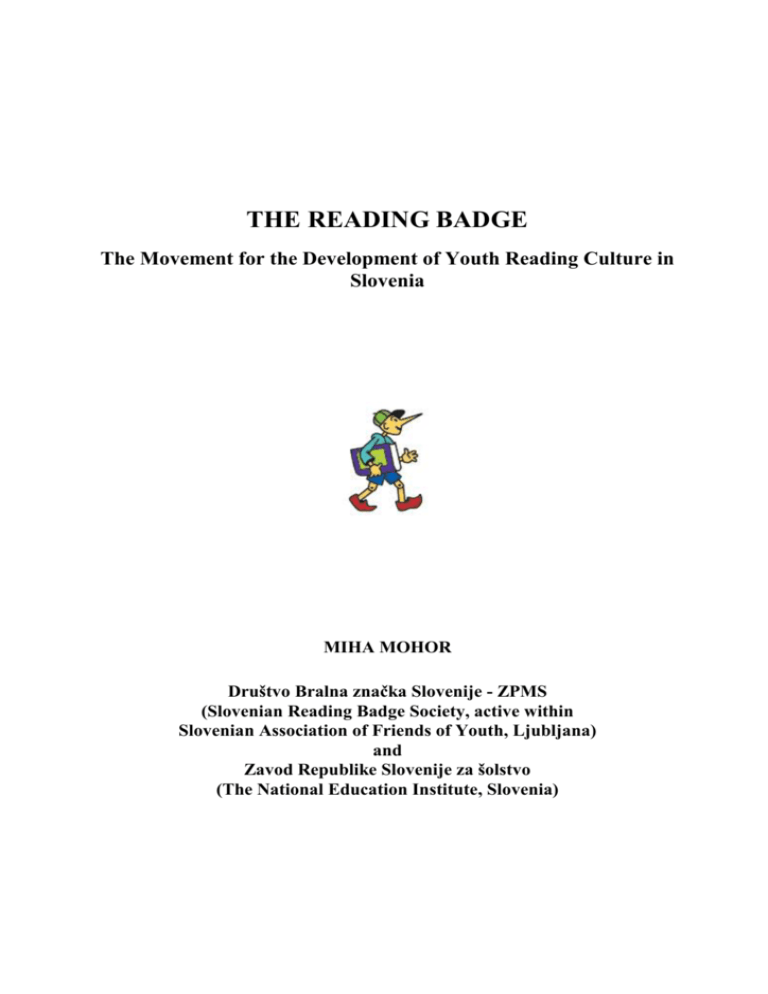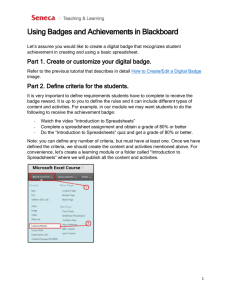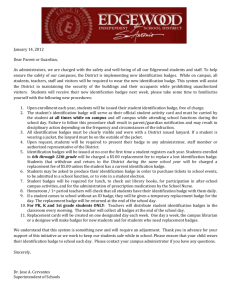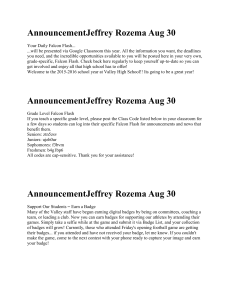pedagogical badges
advertisement

THE READING BADGE The Movement for the Development of Youth Reading Culture in Slovenia MIHA MOHOR Društvo Bralna značka Slovenije - ZPMS (Slovenian Reading Badge Society, active within Slovenian Association of Friends of Youth, Ljubljana) and Zavod Republike Slovenije za šolstvo (The National Education Institute, Slovenia) Slovenian Reading Badge Society is both the name and the “trade mark” of an important cultural and educational movement, of an activity for the development of reading habits and reading culture among the youth. It is one of the most intimate free activities, but at the same time very popular as it includes up to 130,000 preschool and primary school children and a smaller number of secondary school pupils and adults, what is quite a respectable number for a nation of two million people. Teachers and librarians have found The Reading Badge to be an excellent form and opportunity to make good books popular. Within the movement good ways for motivation can be found and children and young adults are taught how to get in touch with literature and they are helped in their search of beauty and values in the rich world of literature. At the same time pupils are directed to technical literature and getting used to dictionaries, encyclopaedias and various handbooks. Thus the slogan “With Books in the World” is definitely appropriate. The Reading Badge movement was founded in the school year 1960/61 at Prevalje Primary School, where Stanko Kotnik, teacher of Slovenian language and literature together with the headmaster Leopold Suhodolčan, a youth writer, turned the existing reading club into “The Competition for the Reading Badge”, quite a challenging activity. Since they knew that pupils did not like reading prescribed books they wanted to find an escape from school formalities. The expansion of all possible sports competitions encouraged them to introduce a new spiritual parallel. The idea of The Reading Badge came to Kotnik while he was reading a report about a similar form of literary education with the Czechs. He grounded the new competition like that: “It is a noble cultural competition where young people compete with their peers and themselves. They are awarded the winning badge for success but at the same time they feel enriched inside.”1 Kotnik and Suhodolčan prepared the regulations where they wrote down the goals, the rules and the procedure of this new activity. A young reader, who decides to take part, is given a full guidance over a number of years. The teacher-mentor gives at his disposal a long list of the best and most suitable books. The reading is intensive and it is accompanied by some written work, a kind of diary of the reading, expressing the reader’s own observations, views, and opinions; all this is followed by conversations in small groups guided by the mentor. Stanko Kotnik wrote: “In a friendly and relaxed contact between the forming young 2 person and his experienced teacher, what is much more difficult to achieve in the regular educational process, the very often hidden motives and reasons for the behaviour of individual characters are fully highlighted. Particular happenings and ideas are considered to reveal the essence of life and the importance of literature.”2 Long before workshops of creative writing became popular in Slovenia, he pointed out that reading and discussions about books also encouraged creative writing. Therefore he suggested a possible cooperation with the literary club. Other activities included in The Reading Badge movement are: literature classes, the organization of book exhibitions, meetings and talks with poets and writers, translators, book illustrators, literary historians, critics, editors and journalists. At the end of each reading period a cultural performance is organized where badges are awarded and winners are taken to the theatre or on the literary excursions by their mentor. The collection of metal badges used to be a favorable hobby among children in the late 1950s. The founders of the movement made good use of it. They turned the badge with the portrait of their Carinthian writer Prežihov Voranc into a reading award. Every reader received a Reading Badge card but the most faithful ones were also given a book prize. Kotnik and Suhodolčan’s idea of getting acquainted with literature in a different way proved to be a new, attractive form of literary education. Thus, it is not surprising that in the next five years a number of badges was added to Prežihov Voranc Reading Badge, carrying the names and portraits of important and popular poets and writers who lived and worked in those regions. Each badge, like sports medals, is made in three variant forms: bronze, silver and gold, which motivated the readers and make them aware of their own personal growth. Since then the list has been enriched to 42 badges. However, we hardly find a school in Slovenia where pupils do not join The Reading Badge. In ten years The Reading Badge spread as a movement to improve reading habits and reading culture not only all over Slovenia, but also abroad, in Slovenian minority schools in neighbouring Italy, Austria, Hungary and among emigrants in the world. Creativity was not reduced to an empty formalism, but with years it has been improved with the help of a large number of native language teachers, librarians, headmasters, and all those enthusiastic 1 2 Stanko Kotnik, Spodbude /Incentives/ (Maribor: Založba Obzorja, 1988), p. 27. Ibid., p. 36. 3 readers, who within this voluntary activity have gathered children of similar souls showing them how to love books. Owing to its expansion it was necessary to link and coordinate various activities. This task was taken by the Board of “The Slovenian Association of Reading Badges”, which worked within Slovenian Association of Friends of Youth, a nongovernment organization. The Board is connected with schools through a net of community branches. In some schools The Reading Badge activity is included in the teachers or librarians timetable workload. On the other hand, there are majority of schools where this kind of work is done as a spare time activity. Anyway, the share of voluntary work is very high. After two successful decades, when a great number of mentors and pupils were included in the work, the movement paradoxically came to a crisis. Mentors were criticized to have forgotten why The Reading Badge movement had been founded, and to use out of date methods, which were quite successful at the beginning, but no longer attracted the generations of television and computers. Many new mentors were beginners without any experience, others without sufficient affinity for reading, who had transplanted The Reading Badge to their school only because of their sense of duty. Imposed set lists of books which had to be read, writing stereotyped “minutes of reading” and an examination form of checking the pupils’ knowledge of literature, was something that was refused by the most enthusiastic readers. Not only pupils were dissatisfied, but negative critiques were coming from all sides: from parent and teachers’ councils, writers’ meetings, and destructive newspaper articles. Most criticism was based on emotion, while no serious research on the problem of the movement was ever made. Although the Board of The Slovenian Association of Reading Badges believed that the critiques were reasonable, they were convinced that the movement should continue because of its vitality and usefulness. Fortunately there were still many schools, where The Reading Badge activities had been enriched by original ideas and suggestions of mentors and pupils. It was necessary to continue with the achievements so as to link the original ideas of the founders of the movement with the new trends and findings. In the course of time The Association grew up into Slovenian Reading Badge Society. The Programme Committee of Reading Badge was formed to monitor the movement and to take 4 care of the basic directives of its development. It has helped mentors with their work by organizing lectures, workshops with inventive teachers, librarians, supervisors, and specialists in the field of youth literature. In this way the democratic aims of the movement have been supported till this day. There have been less prescribed books and mentors’ strict testing, but more club meetings with discussions, and more collaboration with other sparetime activities (such as workshops of creative writing, school magazine editorial staffs, literature or drama clubs, project or research works etc.) and school libraries. The competitive elements, which used to be part of the movement, have proved to be harmful and unnecessary, so they have been cancelled. The principal of individualization plays an important part in the reading for the Badge, therefore the number of books as well as the titles are no longer strictly determined. On one hand the teacher encourages the pupils to read the books he likes, on the other hand he is open to pupils’ suggestions. During the last twenty years The Centre for children’s literature and librarianship in the children’s library in Ljubljana has been preparing annotated lists of recommended youth literature, which have been regularly published in teachers’ newspapers, magazines and in booklets. In this way teachers and mentors are getting acquainted with classical and modern Slovenian and world literature of high quality as well as with useful technical literature and various handbooks. Since 1993 Slovenian Reading Badge Society has been publishing a programme booklet with the timetable of performances held by men and women of letters, musicians, actors, illustrators, publicists and others to ease the organization of accompanying festivals and meetings with the young in schools, kindergartens, libraries, etc. This enables the artists to take an active part in the movement, and with their concerts, literary and theatre performances as well as their talks and lectures, they broaden the reading culture. One of the most important qualities of the movement is its openness to everything that can enrich it. Thus it is not surprising that the international book quiz led by the German institution Stiftung Lesen from Mainz was adapted and incorporated into the movement in the last decade of the 20th century. The quiz encourages the reading habits in large masses of young people particularly the primary school children. Through entertainment and meetings it has reached even those that are not stimulated by regular school programmes or by the reading for the Badge and would never go to the library otherwise. 5 The metal badge has ceased to be an effective motivation for new generations, therefore an alternative form of reward for reading has been suggested by pupils, a folder “With Books in the World”. Primary school children attending the first four classes insert a self-adhesive picture of a popular literary hero in an empty window of the folder. This is their first approach to the world of literature. The change which has been made is of great importance for the child’s understanding of literature. The writer’s portrait, which was occupying the central position in the badge, has been moved to the upper corner of the picture, while the literary hero has taken the central place. In addition to the four pictures pupils can be given a T-shirt with a Pinocchio portrait and the inscription “With the Book in the World”. The child is rewarded for his diligent reading in the first period of his schooling and encouraged for further work. Since 1995 readers from senior primary school classes have been given a folder where they keep both materials (like postcards, extracts from newspapers, Internet material, literary letters, badges and other awards) connected with the book and a personal diary of reading. There are also some “ready made”, printed and illustrated sheets which stimulate pupils’ interest in books and better reading. They try to persuade them to be active, to make lists of the most favourable books, to prepare games based on literature, to solve puzzles, collect and write down literary anecdotes, and try to write poetry following poets’ creative methods, etc. At the same time pupils are directed towards new reading. The newest project of Slovenian Reading Badge Society is “The Golden Reader”: since 2004 each beginner in the primary school has had a picture-book for a gift, and thousands of faithful readers were awarded two books at the end of their elementary schooling. The books have been sponsored by several firms. The Programme Committee of Slovenian Reading Badge Society has thus developed various programmes and actions: The Cradle of Reading informs the parents of new born babies how favourably reading can influence mental and physical growing of the child in the very early years, and how important reading can be for fostering emotional ties. Preschool Reading Badge promotes family reading. It encourages adults, parents, and teachers to read to children. It is carried out by nursery school teachers and librarians in public libraries. Grandma and Grandpa telling is a project to make children and elders meet in reading. 6 The Reading Badge in primary school makes schoolchildren between 7 and 15 read in their free time. The process is carried out by teacher-mentors together with the school library. It may have various forms: such as literary circle, school magazine, young reporters, etc. In Secondary schools Slovenian Reading Badge Society encourages reading, talking about the books, and literary creativity. These activities take place at debate clubs, at meetings with authors, at literary performances, etc. As you see ideas and suggestions how to make the movement more attractive never come to an end. It has been proved to be very energetic and lively in all schools where, thanks to the pupils and mentors’ enthusiasm, it could not get stereotyped. Fortunately there are many schools like that. The principal aim of Slovenian Reading Badge Society is to fill pupils with enthusiasm for reading good literature and to teach them to live with the book after they have left school. In the beginning of the 21st century it has become much more important as it used to be 47 years ago when the movement was founded. 7 REFERENCES Stanko Kotnik. Spodbude /Incentives/: Založba Obzorja, Maribor 1988. Petra Dobrila, “Ob tridesetletnici bralne značke” /Thirty Years of the Reading Badge/, Šolska knjižnica, Vol. I, No. 2, 1991. Berta Golob, “Gibanje za bralno značko potrebuje osvežitev” /The Reading Badge Needs to Be Freshened up/, Vzgoja in izobraževanje, Vol. XVIII, No.1, 1987. Berta Golob, “Vsak poskus se ne posreči, a poskušati je treba” /All Experiments do not Succeed but It’s Worth Trying/, Glasilo DPM, No. 3, 1986. Igor Longyka, “Bralna značka” /The Reading Badge/, Šolska knjižnica, Vol. I, No. 2, 1991. Miha Mohor, “Bralna značka in šolsko glasilo” /The Reading Badge and School Magazines/, Kulturni poročevalec, Vol. XVIII, No.76, 1986. Jože Zupan, “Prehojena pot bralne značke” /The Long Walk with the Badge/, Šolska knjižnica, Vol. I, No. 2, 1991. Bralna značka: 35. sezona /The Reading Badge: the 35th Season/, ed. Igor Longyka and Manca Perko: Zveza prijateljev mladine Slovenije, Ljubljana 1994/1995. Bralne značke danes /The Reading Badges Today/, ed. Leopold Suhodolčan: Zveza prijateljev mladine Slovenija, Ljubljana 1976. Kulturno izročilo bralnih značk /The Cultural Tradition of the Reading Badge/, ed. Jože Zupan: Mladinska knjiga, Ljubljana 1985. Miha Mohor, Bralna značka. Petintrideset let gibanja za razvoj bralnih navad in bralne kulture med slovensko mladino / Reading Badge. 35 years of the movement for the development of reading habits among the Slovenian youth/, Jezik in slovstvo, Issue 4, 1995/96. Miha Mohor, Bralna značka v prenovljeni šoli /Reading Badge in the New School Programs/, Slovenščina v šoli, Issue 4, 1998. Miha Mohor, Bralna značka v kontekstu osnovnošolske prenove /Reading Badge in the Context of Curriculum Modernization/. -In: Code Reading badge in kindergarten and in primary school (Predšolska bralna značka, bralna značka v osnovni šoli; zbornik strokovnega seminarja za mentorje): Zveza prijateljev mladine Slovenije, Ljubljana 2000. Zbornik Bralna značka (The Reading Badge – Code of the seminary/: Bralna značka, Ljubljana 2000. Bralna značka v tretjem tisočletju /The Reading Badge in the 3rd Milenium/: Rokus, Ljubljana 2000. Miha Mohor, Šolska glasila in bralna značka. Dragoceno pedagoško izročilo za novo stoletje /School Magazines and the Reading Badge – Valuable pedagogical tradition for the new millennium /. -In: International symposium code Mother tongues at the threshold of the 21st century (Materni jezik na pragu 21. stoletja): Zavod RS za šolstvo, Ljubljana 2001. Tilka Jamnik, Kdor bere /Who Reads – a handbook for mentors/: Educy, Ljubljana 2002. Pravljični vrtovi, seznam želja in druge dobre zgodbe /Fairy Tales Gardens, a List of Wishes, and Other good stories – List of recommended books from 2003/: Knjižnica O. Župančiča, Ljubljana 2004. SUMMARY The Reading Badge The Movement for the Development of Youth Reading Culture in Slovenia The movement for The Reading Badge was born 47 years ago when teachers of Slovenian language Stanko Kotnik and Leopold Suhodolčan were inspired by the idea of rewarding readers with badges. Their different understanding of youth literature turned out to be an attractive second choice for literary education, and spread to all Slovenian schools. Each year approximately 140.000 preschool and primary school children (Slovenia has a population of 2 million people) read books, and are rewarded with 42 different badges after Slovenian poets and writers. Through the years Slovenian Reading Badge Society has opened an increasingly democratic dialogue between readers and mentors, as well as adding more and more accompanying activities, such as cultural events, gatherings with artists, an international book quiz etc. At the same time it has encouraged and accelerated the development of school libraries and book production for young people. Slovenian Reading Badge Society successfully spreads the reading culture mostly among the young, and it is integrated with all the endeavours for better functional literacy of the individual and the society. The ambitious goal of this movement is to raise a reader who will love and enjoy reading all his life. 8





